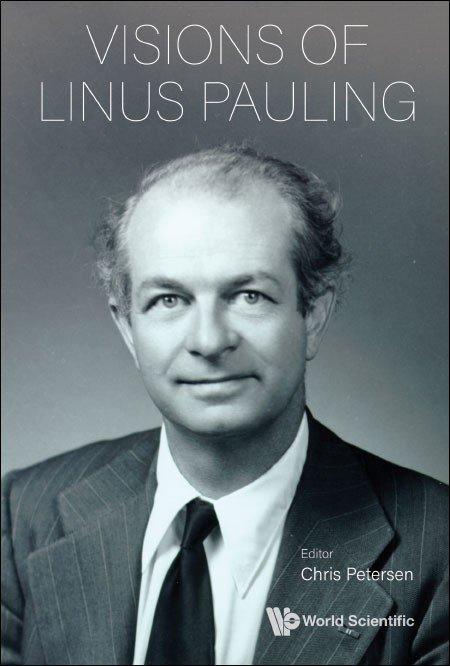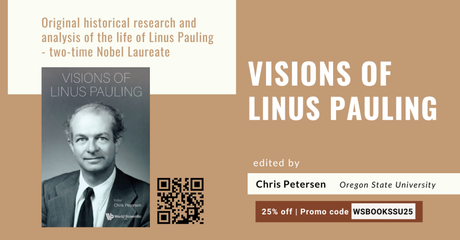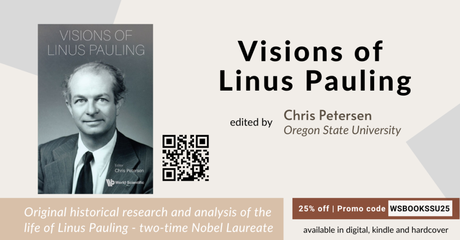
Long-time readers will have noticed that it's been awfully quiet around here in recent months. There are many reasons for this, but one of the biggest is a project that we're very excited to announce today, a book titled Visions of Linus Pauling that is based on a selection of our past writings! It is available for purchase in both hardback and as an e-book, and if you use the promotional code WSBOOKSSU25 you will receive 25% off your order.
Published by World Scientific and edited by Oregon State University archivist Chris Petersen, Visions of Linus Pauling consists of pieces that were originally published on the Pauling Blog, often in serial form, and compiles them for readers in a single, 396-page volume.
As the Pauling Blog consists of over 850,000 words in total, choosing content for the book project naturally required some principles of selection. Instead of taking a more rigorously biographical approach, ultimately we decided to curate material that, in our view, represented substantive contributions to the broader understanding of Pauling and his life.
In certain cases, this led us to select content that was wholly original, such as our biography of Linus Pauling's second-eldest son, Peter, or our examination of the history of his beloved oceanside property, Deer Flat Ranch. In other instances, we chose pieces that provided a different slant on well-known stories, such as our review of Pauling's writing process when penning The Nature of the Chemical Bond, or his experience of the run-up to and formal acceptance of the Nobel Peace Prize. At other times, we opted for content that examined pieces of the Pauling story in great depth; his battle with glomerulonephritis, for example, or his two appearances before the Senate Internal Security Subcommittee. A handful of shorter vignettes are also sprinkled throughout, many of which are meant to provoke a smile from the reader.

The book begins with a Preface that recounts the history of the Pauling Blog and the ways in which it developed as part of a larger Pauling-related program within the Oregon State University Libraries Special Collections and, later, Special Collections and Archives Research Center. Following that is a detailed biographical sketch that provides an overview of Pauling's life to those who are newer to his story.
From there, the book's chapters unfold in chronological order, an arrangement that allows the reader to make connections as time moves forward. One is able, for example, to gain a real sense of the undercurrents of controversy that plagued Pauling for more than a half century, as he faced criticism from groups as varied as the Soviet Academy of Sciences, the National Cancer Institute and even, during his year as president, large factions within the American Chemical Society.
Other connections are more subtle, but potentially more striking. For instance, in the early and mid-1970s, Jack Kevorkian, a medical pathologist who would eventually become internationally known for his active support and engagement with physician-assisted suicide, approached Pauling with the idea that, in Kevorkian's words,
... prisoners condemned to death under capital punishment be allowed to submit, by their own choice, to medical experimentation under surgical anesthesia, to be induced at the set minute of execution, as a form of execution in lieu of the conventional methods prescribed by law.
Kevorkian continued,
[...] Most of us are well aware that the ultimate 'laboratory' for testing every medical fact, concept or device is man himself. [...] In this logical and proper sequence of trial, the human subject, at the end, the 'guinea pig,' is, and always will be, the most difficult link to procure. [...] Viewing the problem purely realistically, capital punishment, as it exists today, offers an unrivaled opportunity to break these limits. It can do this by introducing into the situation an involuntary factor without destroying the necessary safeguard of consent.
Though intrigued, Pauling ultimately declined to endorse this proposal, writing
I think that the best form of execution, if people are to be executed, is the one that causes the person the least suffering. I am not sure that this idea is compatible with your proposal.
Flash forward to the early 1990s and the book's recounting of a cancer diagnosis that would ultimately claim Pauling's life. Though presented with a full compliment of conventional treatment options, and continuing to take the megadoses of vitamin C that had been a mainstay for him since the 1960s, Pauling mostly chose to pursue a highly unorthodox protocol, in part because of his core belief in the advancement of science. From the final chapter of Visions of Linus Pauling,
In a letter to medical writer and cancer consultant Ralph Moss, Pauling detailed a therapy involving autologous anticancer antigen preparation, or AAAP, of which he was somewhat skeptical but nonetheless interested in pursuing. Working with friends and colleagues at Stanford Medical School to raise monoclonal antibodies against his prostate cancer cells, Pauling ultimately conducted what amounted to exploratory and self-experimental science to try and discern the potential value of AAAP. [...]
By July 1992, Pauling had decided to move forward with AAAP treatment, the ultimate goal being a vaccine that would combat his own illness while also providing useful data for the science of the future. Subsequently, a 1-gram section of cancerous tumor tissue that had been surgically removed from Pauling's body was shipped to [the AAAP treatment] lab in New York. Upon entering the operation, Pauling's surgeon had advised him that his entire tumor should be removed, rather than a small section. Pauling refused this request, arguing that a full resection would prevent him and others from observing the effectiveness of the AAAP treatment. In other words, rather than focusing on the fact that his own life was on the line, Pauling was still operating, first and foremost, in the mode of the scientist: he was running an experiment in which he himself was a test subject, and the stakes could not have been higher.
Pauling's choices as a nonagenarian in fading health were, of course, his alone, and were in no way ethically equivalent to those faced by prisoners sentenced to death, nor were they likely informed at all by his correspondence with Kevorkian some two decades before. But for the reader, the juxtaposition of these two stories in a single text might prove compelling, and is an example of what can be gained by engaging with this book.
As with posts on the Pauling Blog, Visions of Linus Pauling generally avoids technical jargon and aims to be of interest to a general audience. Below is the full rundown of chapters and authors featured in the book, which also includes sourcing notes and a detailed index. We hope you'll check it out!
- Preface (Chris Petersen)
- Biographical Sketch of Linus Pauling (Chris Petersen)
- Writing The Nature of the Chemical Bond (Andy Hahn)
- Pauling's Battle with Glomerulonephritis (Carly Dougher)
- W.H. Freeman & Co. (Dani Tellvik)
- Christmas (Linus Pauling Jr.)
- The Soviet Resonance Controversy (Miriam Lipton)
- One Year as President of the American Chemical Society (Madeleine Connolly)
- The Theory of Anesthesia (Trevor Sandgathe)
- Lloyd Jeffress (Trevor Sandgathe)
- Deer Flat Ranch (Matt McConnell)
- Stuck on a Cliff (Megan Sykes)
- The SISS Hearings (Will Clark)
- Unitarianism (Will Clark)
- An Honorary Diploma from Washington High School (Madeline Hoag)
- Receiving the Nobel Peace Prize (Andy Hahn, Jindan Chen and Michael Mehringer)
- William P. Murphy (Ben Jager)
- The National Review Lawsuit (Jessica Newgard)
- Peter Pauling (Matt McConnell)
- Patents (Olga Rodriguez-Walmisley and Trevor Sandgathe)
- Jack Kevorkian and a Twist on Capital Punishment (Chris Petersen)
- The Linus Pauling Institute of Science and Medicine (Adam LaMascus)
- A Funny Story from Andy Warhol (Chris Petersen)
- Quasicrystals (Jaren Provo)
- Pauling's Last Years (Matt McConnell)

Filed under: Site and Department News | Tagged: Visions of Linus Pauling |
